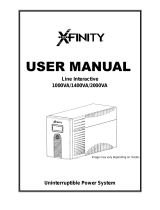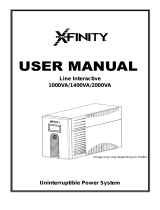
17
Importantes instrucciones de seguridad continuación
• No use este equipo en atmósferas enriquecidas con oxígeno o a distancias inferiores a 0.3 m (1
pie) de un punto en que se ventile deliberadamente una atmósfera enriquecida con oxígeno.
• Tenga cuidado al levantar el UPS. Debido al peso considerable de todos los sistemas UPS, deben
ayudar al menos dos personas para levantarlos e instalarlos.
• Instale su UPS en interiores, alejado de humedad o calor excesivos, polvo o luz solar directa.
• Para mejor desempeño, el UPS debe usarse en una ubicación que cumpla con las siguientes
condiciones: Temperatura: 0 a 40° C (32 a 104° F); Humedad: 0 a 95% (sin condensación);
Elevación: <2,000 m (6,562 pies) sobre el nivel del mar.
• Deje espacio adecuado alrededor del UPS para una ventilación apropiada. No obstruya las
ventilaciones o aberturas de ventiladores.
• No instale la unidad con su panel frontal o posterior viendo hacia abajo (en cualquier ángulo).
El instalar de esta manera inhibirá seriamente el enfriamiento interno de la unidad, causando
eventualmente daño al producto no cubierto por la garantía.
• El UPS no está previsto para contacto con el paciente. Evite la instalación que pudiera causar
contacto accidental con los pacientes.
Advertencias para la Conexión del UPS
• El UPS contiene su propia fuente de energía (batería). Las terminales de salida pueden estar
energizadas, aún cuando el UPS no esté conectado a una alimentación de CA.
• Conecte su UPS a un tomacorriente de CA conectado correctamente a tierra. No modifique
la clavija del UPS en modo alguno que pueda eliminar la conexión a tierra del UPS. No use
adaptadores que eliminen la conexión a tierra del UPS.
• No enchufe su UPS en sí mismo; esto dañará al UPS y anulará su garantía.
• Si está conectando su UPS a un generador de CA activado por motor, el generador de
proporcionar una salida filtrada y con frecuencia regulada.
• Para retirar el UPS de la alimentación del servicio público, la clavija sirve como dispositivo de
desconexión.
• Una vez conectado, no limite el acceso a la clavija de entrada. La clavija debe estar accesible
para usarla como medio de desconexión.
• Al conectar su UPS al tomacorriente de alimentación, asegúrese que el tomacorriente de
alimentación cuente con protección adecuada contra sobrecorriente de acuerdo con sus códigos
eléctricos nacionales y locales. Garantice que la protección contra sobrecorriente tenga una
capacidad de interrupción mínima de 1500A.
PRECAUCIÓN: No retire la cubierta durante 5 minutos después de desconectar
todas las fuentes de alimentación. Riesgo de electrocución—partes energizadas
peligrosas en el interior. No retire la cubierta. No hay en el interior partes a las que
el usuario pueda dar servicio. Remita el servicio a personal de servicio calificado.
Este UPS recibe energía de más fuentes de CD; se requiere la desconexión de la
fuente de CA y CD para desenergizar la unidad antes de darle serviicio.
PRECAUCIÓN: Para garantizar la correcta conexión a tierra con la alimentación
de energía de la red pública, el cable de entrada debe conectarse con una clavija
específica autorizada para el país con una conexión de protección a tierra.
PRECAUCIÓN: Si este producto está operado en respaldo por batería (no está
conectado a la energía de la red pública), deben emplearse las salvaguardas
adecuadas para protegerse contra un contacto accidental con conductores de
energía de CA.
PRECAUCIÓN: No exceda la salida total especificada.
ADVERTENCIA: No se permite ninguna modificación de este equipo.
16-07-004-933608.indb 17 8/31/2016 9:59:48 AM























